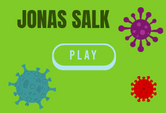Jonas Salk Facts Game Quiz Online
This page features a Jonas Salk Facts Game Quiz Online. It is a great exercise for students in 3rd to 9th grades. He is popular for his development of the vaccine against polio. If you want to learn more about this scientist, try taking this test. It is an interactive fun test that checks your knowledge of some facts about Jonas Salk facts.

As the eldest son of Russian and Jewish immigrants, Jonas Salk was encouraged to do well academically. At the age of 15, he graduated from high school and entered City College of New York. Though he had originally intended to pursue a career in law, his interest in medicine soon took over. He graduated in 1933 with a degree in science. In the years after, he was hailed as a hero by the public and became a famous public intellectual.
Jonas Salk was a Russian-Jewish immigrant
Jonas Salk attended Townsend Harris High School in New York City before entering the City College of New York. Initially, he planned to major in law, but was drawn to the medical sciences. He started studying influenza viruses at the university, which led to his work on polioviruses. However, he did not intend to become a doctor and instead preferred research to medical practice. After graduation, he began his two-year internship at Mount Sinai Hospital in New York.
While in medical school, Salk teamed up with a microbiologist named Thomas Francis, Jr., who helped develop a vaccine to combat influenza. He then went to the University of Michigan, where he became an assistant professor of epidemiology. In 1947, he moved to the University of Pittsburgh, where he was given an appointment as head of the virus research laboratory. From there, he worked to create a vaccine for polio and other diseases.
He studied at Mount Sinai Hospital
After graduating from medical school, Salk began working at Mount Sinai Hospital, a prestigious institution in New York City. Salk had a low grade point average and was Jewish, so the odds were stacked against him in medical school. At most medical schools, only the best Jewish students were accepted, so Salk opted to study at the University and Bellevue Hospital Medical College, now known as New York University School of Medicine.
As a child, Jonas Salk observed the effects of polio firsthand. He vividly recalled seeing soldiers carrying limbs in parades on Armistice Day in New York City in 1918. He was also affected by the sight of his schoolmates wearing leg braces. He was struck by the seemingly never-ending parade of human suffering. So, he chose a life dedicated to the relief of human suffering.
He developed a vaccine against poliomyelitis
Dr. Jonas Salk developed a vaccine against poliomyelitis in the 1950s. Poliomyelitis is an acute disease characterized by crippling paralysis in young children. The Salk polio vaccine prevented paralytic polio by 90%. The disease caused a massive toll in both lives and residual disabilities. In the early 1900s, there were 58,000 new cases and 3,000 deaths in the United States. A few months later, Dr. Salk was recognized as one of the greatest doctors of all time.
Although poliomyelitis killed over thirteen hundred people and disabled 18 thousand, the 1950s are still remembered as the safest and most prosperous decade in the history of the United States. The vaccine developed by Jonas Salk is safe, potent, and effective. He became the nation's first celebrity scientist. But the research on the vaccine didn't stop with Salk. Many other scientists and physicians contributed to the life-saving vaccine.
He was a charitable figure
Jonas Salk was a physician, author, and public figure. He founded the Salk Center for Biological Studies in 1963, and was its founding director until 1975. Although his groundbreaking research saved millions of lives, he avoided the limelight. He also found himself under fire from many of his peers for his publicity-loving ways. But Salk never lost the desire to learn and to spread his knowledge. His passion for science led him to start the Salk Institute for Biological Studies in 1962. With the help of the March of Dimes, he continued his work, and his institute expanded into multiple sclerosis, cancer, and AIDS research.
Salk also sought to bring the vaccine to a wider audience. Even before the Watson Home trials, he wanted to test the vaccine. Many of the patients there loved him, and he had a way of calming even the most fearful child. In addition to his compassionate nature, Dr. Salk remembered every patient by name and even joked with them about their favorite movie stars. His love for children clearly influenced his decisions and led to his work.
He founded the Salk Institute for Biological Studies
The vision of Dr. Jonas Salk for his institute led to the creation of a world-class campus in La Jolla, California. The East Building, which stands 125 feet east of the main complex, was designed by renowned architect Louis I. Kahn in the early 1960s. As the name suggests, it is a landmark for the scientific community, and the Institute's name is synonymous with excellence.
In 1960, the Salk Institute approached the city of San Diego to get a piece of land on Torrey Pines Mesa. The city granted the Institute a generous gift, and construction began in 1962. The architect, Louis Kahn, based his design on a simple, low-maintenance concept. He commissioned Kahn to create a facility worthy of Picasso, who visited the Institute.
